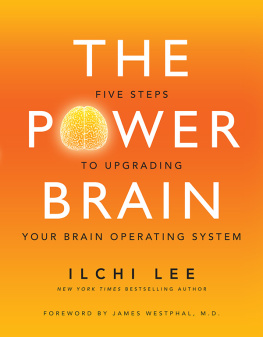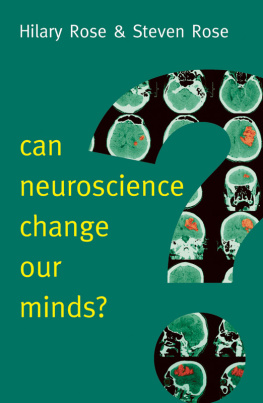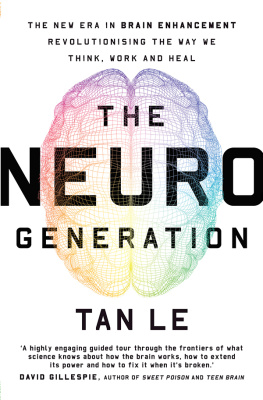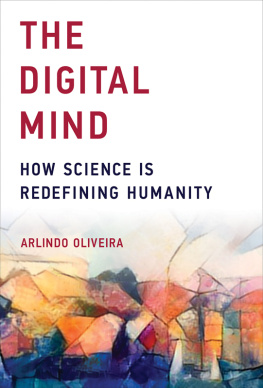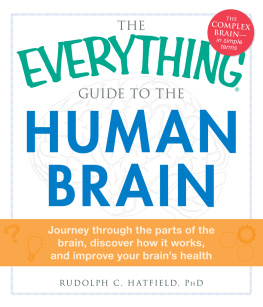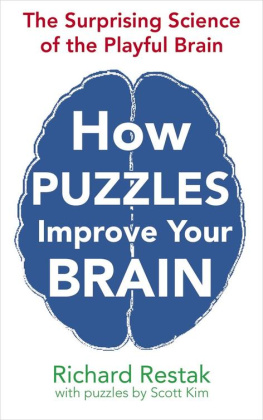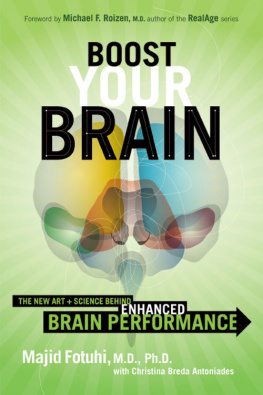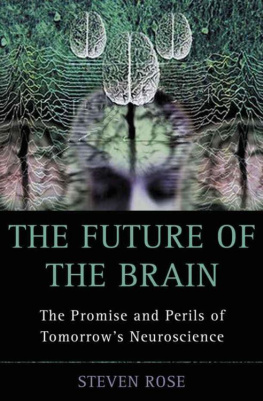Contents
Guide

The author and publisher have provided this e-book to you for your personal use only. You may not make this e-book publicly available in any way. Copyright infringement is against the law. If you believe the copy of this e-book you are reading infringes on the authors copyright, please notify the publisher at: us.macmillanusa.com/piracy.
For my parents, all four of them
Man exists only insofar as he is separated from his surroundings. The cranium is a space-travelers helmet. Stay inside or you perish It may be wonderful to mix with the landscape, but to do so is the end of the tender ego.
Vladimir Nabokov, Pnin
The plan, which had already elbowed out the other six cycling through Eric Leuthardts head that day, was to peel back the scalp, pry open the skull, and install a web of electrodes atop D. Brookmans brain. Barring any unforeseen circumstances, Leuthardt hoped to slip an additional phalanx of sensors behind Brookmans left hemispherebut not before hed plunged five more deep into the brain itself, tunneling through its mille-feuille of neurons to home in on the epileptic root. A routine procedure, to be sure, and if all went as planned, Leuthardt would have the scalp stapled shut by noon, allowing him time to update the family before heading into an ideas session about enzyme-based treatments for Alzheimers disease.
It was a typical morning for Leuthardt, rising before dawn for surgery and then trekking from the operating room to the research bench, an invention session, or a meeting with medical device manufacturers. In his dealings with others, he had proven to be collaborative, intense, and eager to please. Now in his early forties, Leuthardt had a muscular build, a thick head of brown hair, and a sloping nose that supported a small pair of glasses. He also possessed that fabulous ability to yoke together worlds previously discrete, binding brain surgery to research, research to the private sector.
Today would be no different. Leuthardt hoped his electrodes would act as a sort of neural seismometer, helping him to pinpoint the source of Brookmans seizures. But diagnostics were only part of the project. Leuthardts electrodes would serve a second function as well: by melding his platinum sensors to the brain, he hoped to eavesdrop on Brookmans thoughts, creating a link between his patients brain and the digital world outside.
Leuthardt wasnt angling for thoughts as we know themconscious considerations like I feel hungry and what a lovely sunset. He was after the electric current of thought itself: the millions of electrical impulses, known as action potentials, that continuously volley between the brains estimated 100 billion neurons. Those neurons are connected by an estimated 100 trillion synapses, the slender electrochemical bridges that enable the craniums minute universe of cells to communicate with one another. Like an exponentially complicated form of Morse code, the cells of the brain exchange millions of action potentials at any moment, an electric language that physically underlies our every movement, thought, and sensation. These are not sentient thoughts, per se, but in sum this mysterious and crackling neural language is what makes consciousness possiblea sort of quantum programming code that remains all but unrecognizable to the consciousness it creates.
Leuthardts hope was to understand that language. Using electrodes to ferry Brookmans neural signals into a nearby computer, he would forge whats known as a brain-computer interfacea wildly intricate union of synapses and silicon that would grant his patient mental control over computers and machines. As this pulsing language streamed from Brookmans brain, the machines algorithms would work to find repeated patterns of cellular activity. Each time Brookman would think, say, of lifting his left index finger, the neurons associated with that action would crackle to life in a consistent configuration. Working in real time, the computer would analyze those patterns, correlating them with specific commandsanything from re-creating the lifted finger in a robot hand to moving a cursor across a monitor or playing a video game. The end command hardly mattered: once Leuthardts computers had adequately decoded Brookmans neural patternshis thoughtsLeuthardt could conceivably link them to countless digital environments, granting Brookman mental control over everything from robotic appendages to Internet browsers.
Its a union whose potential beggars the imagination: an unprecedented evolutionary stepeffectively digitizing the bodys nervous systemthat conjures images of not only mental access to everyday objects like computer networks, appliances, or the so-called Internet of things but also telekinetic communication between people and cyborg networks connected by the fundamental language of neural code.
Just as the bodys nervous system comprises both sensory and motor neurons, the wired brain offers an analogous two-way means of communication. Brookmans brain-computer interface may give him control over computers, but it would also grant Leuthardts computers access to Brookmans braina powerful research tool to study the behavior of individual neurons as well as deliver new forms of sensory information.
We may actually for the first time be able to interact with the world in a nonmuscular manner, Leuthardt said. Ive always needed muscle to communicate with you by moving my vocal cords or giving a hand expression or writing a note or painting a paintinganything. But that may not be the case anymore. So how does that change us? You unlock the mind and make it accessible to science and technology, and suddenly all this other stuff becomes possible. Everything changes. Its a whole new palette for the human imagination.
* * *
By the time he arrived for pre-op at the Barnes-Jewish Hospital complex in St. Louis, Brookman had already slipped into an anesthetic stupor. Waaaaassup, he murmured through an opiate haze as nurses wheeled him into Neuropod 5, a surgical unit deep within the hospital. Outside, the September morning was cool and crisp. But here in the sterile confines of the operating room, nature had been all but banished as Leuthardt prepared to remove a section of his skull.
At thirty years old, Brookman had the lean, taut-skinned look of an athlete. His cheekbones were high and wide. They sloped sharply toward his delicate wedge of a chin. His hazel eyes were set far apart, and he trimmed his brown hair shortbut not so short as to reveal the surgical scar that snaked around his head like the seam of a baseball.
That scar, the shiny memento of a failed surgery three years earlier, was on full display as nurses hoisted him from the gurney to the operating table. A network of washer-like rings studded his shaved scalp, and his bare chest, draped to the armpits in a blue cotton sheet, shuddered with each shallow breath. His hands lay listlessly by his sides, while his right eye traced blind arcs across the room.
Brookman had come to St. Louis in a last-ditch effort to vanquish the rare form of epilepsy that had gripped him since infancy. Nearly half of all epileptic seizures originate in the temporal lobes, twin brain structures that wrap around the side of the brain like a pair of folded wings. But Brookmans seizures erupted in the parietal lobe, a mysterious brain region that helps unify our experience of touch, sound, and other sensory information.
Seizures in the parietal lobe will often cause pain to radiate from a persons head to his arms and legs. Occasionally, they cause hallucinations. Some people lose their ability to process language or will perceive their bodies as wildly contorted. In rare cases, they orgasm.


